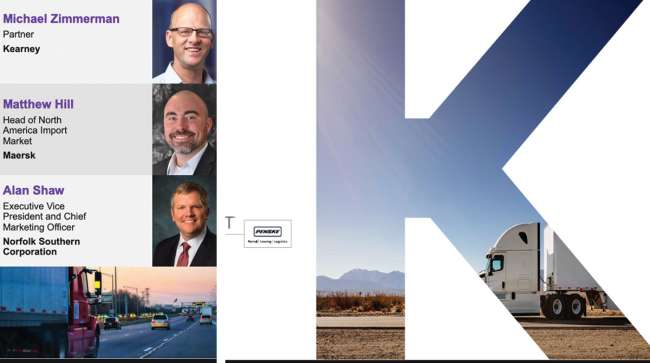Staff Reporter
Logistics Sector Altered but Resilient, CSCMP Reports

[Stay on top of transportation news: Get TTNews in your inbox.]
The logistics sector continues to demonstrate the perseverance that carried it through the toughest days of the economic downturn that accompanied the coronavirus pandemic, the Council of Supply Chain Management Professionals said in a recent report.
“Last year we relayed that the resilience of logisticians was tested,” said Michael Zimmerman, a partner at Kearney and one of the speakers who presented the 2021 CSCMP State of Logistics Report during a June 24 online event. “This year the story is one of adaptation under the most severe conditions in memory. Shippers and carriers had to continuously change plans as the means of logistics they relied on strained and sometimes broke.”
The report, released June 23, highlighted how the logistics sector fared over the past year and explored what is likely ahead.
Released today, the 32nd Annual State of Logistics Report®, produced for CSCMP by global consulting firm Kearney and presented by Penske Logistics, finds supply chains continuing to reset from the pandemic. Get your copy! https://t.co/BeZ8uZ7mFX #SoFL #StateofLogistics pic.twitter.com/F90NEv9AJ8 — cscmp (@cscmp) June 24, 2021
The report found transportation costs as a subset of business logistics rose slightly in 2020, but results varied substantially by sector. Motor carriers fell 0.6% with volumes and rates falling early in the pandemic, but then inventory replenishment and supply chain restarts drove growth throughout the second half of 2020. Business logistics costs fell 4% in 2020.
“Most logisticians will be surprised by this drop, expecting a rise,” Zimmerman said. “But shipping volume and price drops in the first half had a big impact. The financial cost of inventories fell as interest rates were lowered and the inventory-to-sales ratio hit 20-year lows in May of 2020.”
The report also found that a surge in e-commerce and changes in consumer behavior drove parcel costs up 24.3%. Rail was down 11%, which was driven by declining volumes. Water transport fell by 28.6%. Inventory storage costs grew 1.4% as warehousing growth remained strong.
“The national economy shrank by 3.5% as the pandemic upended both supply and demand,” Zimmerman said. “The logistics industry declined a bit more than the broader U.S. economy to $1.56 trillion in expenditures. On the plus side, the global and U.S. economies are recovering with U.S. GDP expected to grow by more than 7.7% in 2021 before slowing to 4.5% in 2022.”
Zimmerman added that upheaval in the supply chains last year created chaos that placed demands on logistics. This resulted in higher prices for logistics services despite the shrinking economy. At the same time, logistics costs accounted for a lower percentage of GDP at 7.4% compared to 7.6% in 2019.
“Shippers and carriers alike should plan for optionality in the face of instability,” Zimmerman said. “Logistics, like the economy as a whole, is in the midst of another wild ride in 2021. A lot of the story behind the wild ride can be discerned in consumer confidence.”
Get your copy of this year’s State of Logistics Report by CSCMP, Kearney, and Penske Logistics aptly titled: “Change of Plans”. In the meantime, enjoy this key takeaway on the #3PL sector. https://t.co/EVIx8bnUiV #SoFL #StateofLogistics #ChangeofPlans #ThisIsSupplyChain pic.twitter.com/1HnHfHf8TO — cscmp (@cscmp) June 24, 2021
Zimmerman added buyers and sellers alike curbed expenditures early in the pandemic. But then the government stimulus resulted in a premature celebration that the pandemic was ending. When the pandemic surged back it created gyrations in confidence and expenditures. Supply chain companies having to change plans constantly led to inefficiencies.
“Inventory ratios are now virtually one-to-one,” said Kevin Smith, report panel chair president and president of Sustainable Supply Chain Consulting. “They’ve never been that low before. And that means essentially that companies have about one month’s worth of inventory.”
Smith added that only a decade or two ago these inventory ratios would have been a big problem because they lacked visibility and modern processes. Thus far it’s been a challenge supply chains can handle, but he warns it’s not sustainable in the long term.

Paul Bingham by CSCMP
“What happens after 2022?” said Matthew Hill, head of the North American import market at A.P. Moller-Maersk. “Speaking with some customers last week, the indication around this ‘just in time’ approach going forward — they’re almost laughing that is not something that’s going to be sustainable for them.”
Paul Bingham, director of transportation consulting at IHS Markit Economics, highlighted how a lot of existing trends have accelerated because of the pandemic.
“The economic implications of that are substantial so that we’re not going to revert to a 2019 world,” Bingham said. “That actually has some payoff. The acceleration of some of that investment in digitalization, or even the willingness of customers to use tools like that, or to engage more intelligently in acknowledging the importance of supply chain logistics, is probably long-lasting and beneficial to the economy.”
Want more news? Listen to today's daily briefing below or go here for more info:


